Highlights
- The gender gap in relationship status is often misunderstood. Post This
- While men are more likely than women to be “never married,” they are also more likely to be currently married. Post This
- At older ages, men are more likely to be married than women. This is due to two forces: divorce and widowhood. Post This
Vox recently published an article asking “Why are single men so miserable?” highlighting the unique challenges faced by single men and the fact that young men are more likely to be unmarried than young women. While it’s true that young men are more likely to be single by several measures, including being “never married,” the gender gap in relationship status is often misunderstood.
Viewing relationship status by sex is important since romantic relationships benefit men and women differently. Men, for example, receive a higher “marriage advantage” against deaths of despair than women do. Similarly, divorce and widowhood affect men and women differently, including for psychological and financial outcomes.
Some might interpret the fact that young men are more likely to be single than young women as the result of a few men being in a relationship with multiple women at the same time. Such an interpretation ignores the fact that while men are more likely than women to be “never married,” they are also more likely to be currently married.
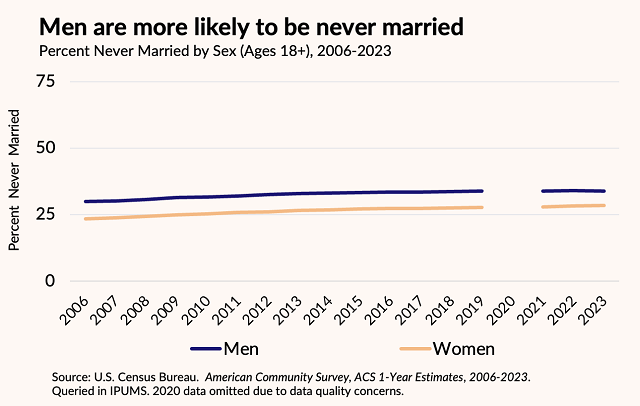
Among all U.S. adults in 2023, approximately 49% of women were currently married compared to 53% of men.
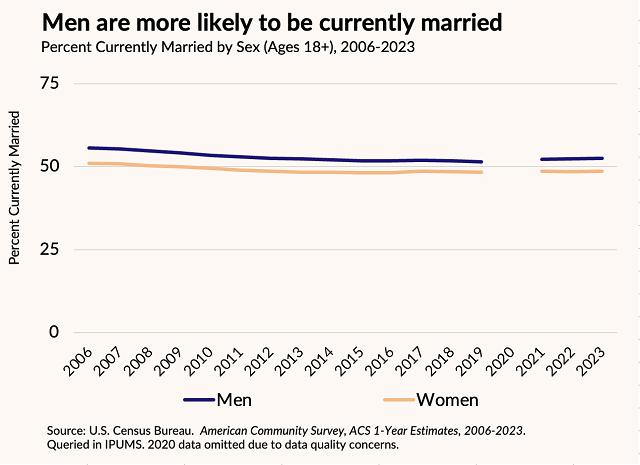
These seemingly contradictory facts—that men are both more likely to have never married and to be currently married—aren’t paradoxical. Instead, they reflect differences in the timing of marriage, divorce, remarriage, and mortality between the sexes.
Understanding the Gender Gap in Marriage
Much of the confusion comes from focusing only on young adults. Young men are indeed less likely than young women to be married. Among U.S. adults ages 25-34, approximately 42% of women are married compared with only 35% of men in 2023—a gap of about 7 percentage points. Interestingly, this gap has stayed relatively constant despite rising ages at marriage and changing rates of marriage.
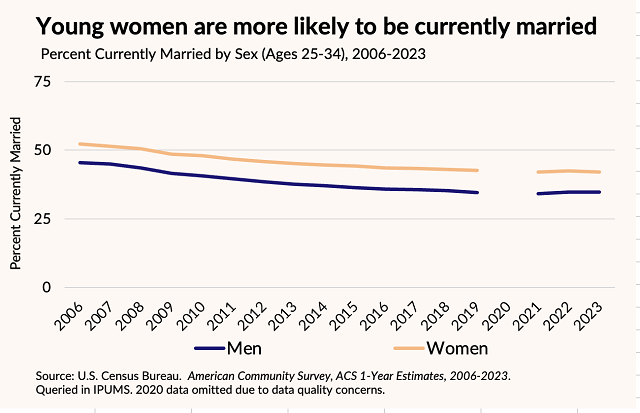
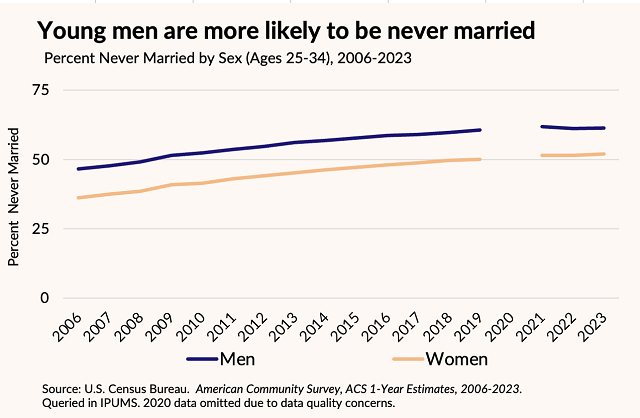
Yet this gender gap at younger ages is due less to differences in the likelihood of ever getting married and more to sex-differences in when men and women get married. Like in many populations, women in the U.S. get married younger, on average, than men. In 2024, the median age of first marriage was 30.2 for men and 28.6 for women. By age 34-44, therefore, the sex-difference in the likelihood of being married largely disappears; among those 35-44, 60% of men and 61% of women are currently married.
Similarly, the sex-difference in the likelihood of being never married disappears with age. Among those 65 and over, the percentage who have never married is very similar for both men and women—approximately 7% for both men and women in 2023. That is, despite differences in when they get married, men and women have similar lifetime likelihoods of ever being married.
Despite differences in when they get married, men and women have similar lifetime likelihoods of ever being married.
Other social forces, however, shape the gender gap in the likelihood of being currently married. At younger adult ages, different ages at marriage explains why younger women are more likely to be married than younger men.
The Gap is Largest for Older Adults
Yet a sex differential reappears at older ages, only in the opposite direction. At older ages, men are more likely to be married than women. This is due to two forces: divorce and widowhood.
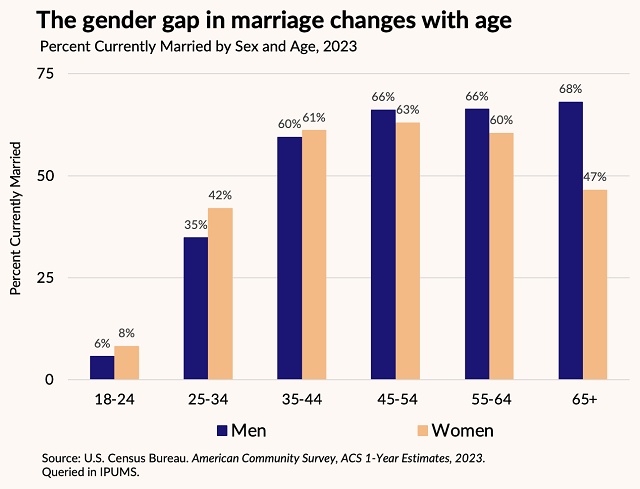
Divorced men are more likely to get remarried than are divorced women. This leaves the population of those divorced—and not currently married—disproportionately female. Among all U.S. adults whose marital status is “divorced,” there are only 73 men for every 100 women. Because getting divorced necessarily occurs after getting married, the divorced population is older. This partially explains why men are more likely than women to be currently married in older age groups.
Men are also more likely than women to be married at older ages because women are more likely to be widows. The population of widows is disproportionately female because men have higher mortality rates. Among widowed U.S. adults, there are only 31 widowed men for every 100 widowed women. Because death occurs more frequently at older ages, widowhood mostly effects older age groups. Over a quarter (29%) of women ages 65 and over in the U.S. are widows.
As a result of these forces—divorce and widowhood—that differ by sex and occur more at older ages, the gender gap in being currently married is largest at older ages. Sixty-eight percent of men ages 65 and over are currently married while less than half (47%) of women ages 65 and over are currently married—a gap of about 22 percentage points.
Who Is More Likely to Be Married?
So, then, who is really more likely to be married—men or women? The answer largely depends on age. At younger ages, women are more likely to be married, mainly because they marry earlier than men. But at older ages that dynamic flips—men are more likely to be married, due to higher rates of remarriage following divorce and lower rates of widowhood. By age 65 and up, the gender gap in marriage is stark: nearly 7 in 10 men are currently married, compared to fewer than half of women. This gap exists despite similar percentages of being ever married.
These statistics are not a paradox—just demography. Marriage timing, divorce, and death shape the gender gap in marital status across the life course, but understanding these differences by sex is more than statistical curiosity. Because marriage offers different benefits by sex, correctly understanding when and why men and women are married is essential to understanding the broader story of family life and equality in America.
Anne Morse holds a PhD in Demography and Sociology.
*Photo credit: Shutterstock









